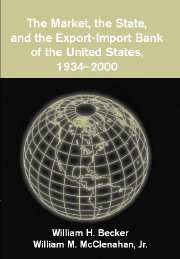Book contents
- Frontmatter
- Contents
- Preface and Acknowledgments
- Introduction
- 1 Setting a Flexible Course: The Export-Import Bank, 1934–1939
- 2 World War and Its Aftermath
- 3 Cold War and the Needs of a New Era, 1948–1961
- 4 Becoming “Two Institutions”
- 5 New Mandates and New Limits
- 6 Turmoil and Turning Points
- 7 A New Era and Its Challenges, the 1990s
- Epilogue
- Appendix A Board of Directors
- Appendix B Summary of Authorizations
- Appendix C Number of Authorizations
- Appendix D Charges Against Statutory Limitations on Total Activity
- Index
Preface and Acknowledgments
Published online by Cambridge University Press: 13 July 2009
- Frontmatter
- Contents
- Preface and Acknowledgments
- Introduction
- 1 Setting a Flexible Course: The Export-Import Bank, 1934–1939
- 2 World War and Its Aftermath
- 3 Cold War and the Needs of a New Era, 1948–1961
- 4 Becoming “Two Institutions”
- 5 New Mandates and New Limits
- 6 Turmoil and Turning Points
- 7 A New Era and Its Challenges, the 1990s
- Epilogue
- Appendix A Board of Directors
- Appendix B Summary of Authorizations
- Appendix C Number of Authorizations
- Appendix D Charges Against Statutory Limitations on Total Activity
- Index
Summary
In 2000, the Export-Import Bank of the United States (Ex-Im) marked its sixty-fifth anniversary. Ex-Im is the United States' export credit agency (ECA). It is a federal entity dedicated to promoting American exports by providing loans, guarantees, and insurance, without competing with the private sector. Many other countries have ECAs, including all the world's major industrial exporting countries. Throughout its history, Ex-Im has served the interests of the American exporter community, while also attending to the public policy goals of the executive branch and Congress. For almost half of its recent history, Ex-Im has played a part on the world scene by contributing to the United States' efforts to promote freer trade – leveling the playing field by standardizing practices among ECAs – through negotiations at the Organization for Economic Cooperation and Development (OECD).
At the turn of the century, the Bank was confronting a series of changes in private international capital markets and in the practices of other ECAs. In the last two decades, Ex-Im conducted its business in the midst of major international financial crises in Latin America in the 1980s and Southeast Asia in the late 1990s. Like other private and public institutions, Ex-Im also had to face up to the opportunities and challenges of the revolution in information technology and the arrival of the Internet. In addition, as an institution operating on the world scene, Ex-Im had to pay heed to the demands of nongovernmental institutions devoted to environmental causes.
- Type
- Chapter
- Information
- Publisher: Cambridge University PressPrint publication year: 2003



